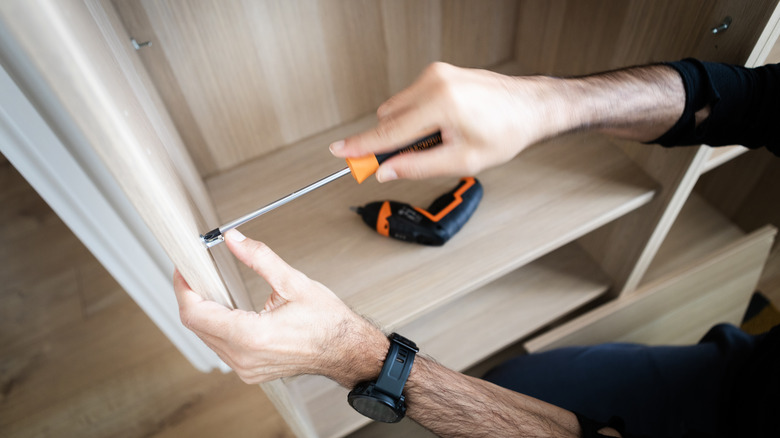You Actually Can DIY Built-In Shelves Over Baseboard Heat. Here's How
We may receive a commission on purchases made from links.
Installing built-in shelves is one of those home renovation projects that can completely reinvent a space, instantly making an interior feel custom, intentional, and high-end. But if you're tackling this project yourself, you may have run into one major obstacle: baseboard heating. These heaters are notoriously tricky to work around. Not only do they prevent furniture from sitting flush against the wall, but placing anything too close to them can quickly become a fire hazard, especially if it has draped fabric. That sleek wall-to-wall storage system suddenly seems impossible without a complete renovation of your home's heating layout. Fortunately, there's a simple DIY workaround that preserves both style and safety. Whether you're installing shelves, a built-in dresser, or a floating desk, this trick makes it easy to pull off the look without sacrificing your heat source.
The primary concern with building around baseboard heaters is airflow. These units work by pulling in cool air from the floor, heating it, and allowing it to rise into the rest of your space. Blocking its path doesn't just trap hot air, but can actually disrupt the system entirely. Don't cover your baseboard heaters, as it can lead to ineffective heating, higher energy costs, and in some cases, damage to your furniture. The key is to elevate the shelving system slightly to allow hot and cold air to move freely underneath your furniture, leaving plenty of space for airflow. With the right materials and a little planning, you can construct a simple platform that looks like it is part of your intended furniture. It's a small change, but it goes a long way in ensuring your DIY installation is safe, practical, and aesthetically pleasing.
Build a platform that works with your heater
To start your custom installation process, measure the base of your shelving system or built-in dresser, taking note of your baseboard heaters. You will need a sheet of ¾-inch plywood to match the dimensions of your furniture. Using the plywood, you will essentially create a platform on which your furniture will sit. The platform itself shouldn't have an enclosed base, but rather only front legs, allowing air to flow across the floor of your home. Be sure that you leave at least a 6-inch clearance in front of the heater to prevent potential damage or fire hazards. Once your platform shape is finalized, dry-fit it against the heater to ensure that it fits properly, being mindful of the necessary clearance, before securing it to your walls. This subtle lift will help allow warm air to flow under the unit rather than becoming trapped behind it, which can make a major difference in performance.
Additionally, remaining mindful to protect heat flow, you can incorporate functional elements into your built-ins, adding decorative touches to your platform. A scalloped trim may make your piece feel outdated, but subtle cosmetic elements may create a more seamless look. Once these elements are finished, ensure that the platform is level before placing your furniture on top of it. When done correctly, it should sit flush against the wall, and you should be able to feel airflow underneath.
Customize your built-in shelves without comprising heat safety
Once your shelves or furniture are installed, it's time to make the whole piece feel seamless. Start by sealing the joint between the platform and your piece of furniture with a bit of heat-resistant caulk or wood filler to help create a cleaner look. This will also prevent dust or drafts from seeping in between the two surfaces. On the exterior, you can also add a thin piece of trim to further cover up the seal. If you plan to paint your design, make sure the paint can handle heat exposure. Standard paints might peel or yellow over time as they are exposed to repeated warmth, especially on surfaces close to the heater's airflow path. A heat-tolerant enamel, such as ForceField Flame Retardant and Protection, will ensure that your built-ins retain their polished appearance.
You can also take this opportunity to add other decorative elements to your platform and furniture. Adding a small piece of baseboard-style molding to the bottom edge of your platform can help it blend into your decorative furniture while also hiding the gap at the bottom. Just be mindful not to block the airflow during the customization process. If you want to lean into a more deliberate aesthetic, consider using slatted wood or metal embellishments, like these Antique Metal Decorative Box Bumpers, to harmonize the space under your platform. This can be an excellent way to conceal the heater under your platform without compromising its effectiveness. With these small yet effective tweaks to get around your baseboard heaters, you may be able to lower the cost of building built-in shelves from scratch.

